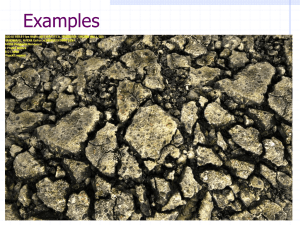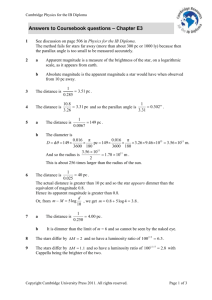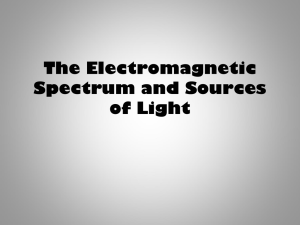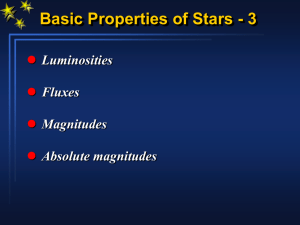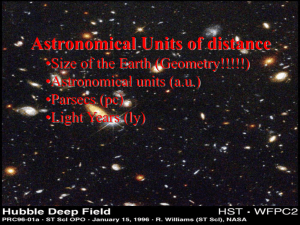ppt
advertisement
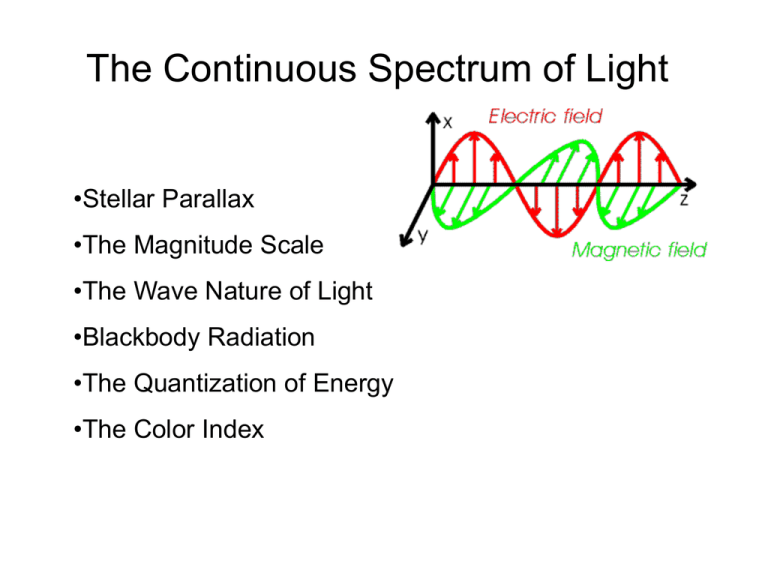
The Continuous Spectrum of Light •Stellar Parallax •The Magnitude Scale •The Wave Nature of Light •Blackbody Radiation •The Quantization of Energy •The Color Index Stellar Parallax • Trigonometric Parallax: Determine distance from “triangulation” tan q = B /d d = B /tanq • Parallax Angle: One-half the maximum angular displacement due to the motion of Earth about the Sun (excluding proper motion) 1AU 1 d= » AU tan p p With p measured in radians PARSEC/Light Year • • • 1 radian = 57.2957795 = 206264.806” Using p” in units of arcsec we have: 206,265 d» AU p" Astronomical Unit of distance: PARSEC = Parallax Second = pc 1pc = 2.06264806 x 105 AU • The distance to a star whose parallax angle p=1” is 1pc. 1pc is the distance at which 1 AU subtends an angle of 1” d» • • 1 pc p" Light year : 1 ly = 9.460730472 x 1015 m 1 pc = 3.2615638 ly •Nearest star proxima centauri has a parallax angle of 0.77” •Not measured until 1838 by Friedrich Wilhelm Bessel •Hipparcos satellite measurement accuracy approaches 0.001” for over 118,000 stars. This corresponds to a a distance of only 1000 pc (only 1/8 of way to centerof our galaxy) •The planned Space Interferometry Mission will be able to determine parallax angles as small as 4 microarcsec = 0.000004”) leading to distance measurements of objects up to 250 kpc. Parallax determination of distance to Venus http://venustransit.nasa.gov/2012/articles/ttt_75.php The Magnitude Scale • Apparent Magnitude: How bright an object appears. Hipparchus invented a scale to describe how bright a star appeared in the sky. He gave the dimmest stars a magnitude 6 and the brightest magnitude 1. Wonderful … smaller number means “bigger” brightness!!! • The human eye responds to brightness logarithmically. Turns out that a difference of 5 magnitudes on Hipparchus’ scale corresponds to a factor of 100 in brightness. Therefore a 1 magnitude difference corresponds to a brightness ratio of 1001/5=2.512. • Nowadays can measure apparent brightness to an accuracy of 0.01 magnitudes and differences to 0.002 magnitudes • Hipparchus’ scale extended to m=-26.83 for the Sun to approximately m=30 for the faintest object detectable Flux, Luminosity and the Inverse Square Law • Radiant flux F is the total amount of light energy of all wavelengths that crosses a unit area oriented perpendicular to the direction of the light’s travel per unit time…Joules/s=Watt • Depends on the Intrinsic Luminosity (energy emitted per second) as well as the distance to the object • Inverse Square Law: L F= 2 4pr Absolute Magnitude and Distance Modulus • • Absolute Magnitude, M: Defined to be the apparent magnitude a star would have if it were located at a distance of 10pc. Ratio of fluxes for objects of apparent magnitudes m1 and m2 . F2 = 100(m1 -m 2 )/ 5 F1 • Taking logarithm of each side æ F1 ö m1 - m2 = -2.5log10ç ÷ è F2 ø •Distance Modulus: The connection between a star’s apparent magnitude, m , and absolute magnitude, M, and its distance, d, may be found by using the inverse square law and the equation that relates two magnitudes. 2 100 (m-M )/ 5 F10 æ d ö = =ç ÷ F è10 pc ø Where F10 is the flux that would be received if the star were at a distance of 10 pc and d is the star’s distance measured in pc. Solving for d gives: (m-M +5)/ 5 d =10 pc The quantity m-M is a measure of the distance to a star and is called the star’s distance modulus æ d ö m - M = 5log10 (d) - 5 = 5log10 ç ÷ 10 pc è ø The Continuous Spectrum of Light •The Nature of Light •Blackbody Radiation •The Color Index Speed of Light • Ole Roemer(1644-1710) measured the speed of light by observing that the observed time of the eclipses of Jupiter’s moons depended on how distant the Earth was from Jupiter. He estimated that the speed of light was 2.2 x 108 m/s from these observations. The defined value is now c=2.99792458 x 108 m/s (in vacuum). The meter is derived from this value. • Measurement of speed of light is the same for all inertial reference frames!!! Special Relativity (will come back to this topic..soon) Takes an additional 16.5 minutes for light to travel 2AU The Nature of Light • • Newton believed that like was “corpuscular”, particle-like in nature…due to sharpness of shadows. Christian Huygens (1629-1695) believed that light was wave-like, with a distance between succesive peaks (troughs) of wavelength and that the number of waves per second that pass a point in space is the frequency of the wave. The speed of light is then given by : c = ln • Particle and wave models could explain reflection and refraction of light…wave nature of light demonstrated by Thomas Young’s double slit experiment… The Wave Nature of Light • Light impinging on double slit • Exhibits Inerference pattern Interference condition ì nl ï d sinq = í 1 ïî(n - )l 2 (n=0,1,2,…for bright fringes) (n=1,2,…for dark fringes) INTERFERENCE http://vsg.quasihome.com/interfer.htm WAVE What is Light? And God said…let there be light Maxwell’s Equations in Free space and there was light…. Electromagnetic Wave equation Wavelike Nature of light • Light is an electromagnetic phenomenon Heinrich Hertz’s Apparatus for the production and detection of radio waves Deutsches Museum Munich Changing electric field Propagates through free space Changing Magnetic Field Nothing is waving!!!! EM waves created by accelerating charges Accelerating Charge causes Electromagnetic Waves • Electric Field emanates from electric charges • What happens to field when charge is accelerated? • “Kink” in electromagnetic field propagates with finite velocity http://www.phy.ntnu.edu.tw/ntnujava/index.php?topic=322.0 Electromagnetic Waves Electromagnetic Wave speed Light is indeed an Electromagnetic Wave Waves are Transverse Electromagnetic Spectrum Region Gamma Ray X-Ray Wavelength nm 1 nm<10 nm Ultraviolet 10 nm<400 nm Visible 400 nm<700 nm Infrared 700 nm<1 mm Microwave Radio 1mm<10 cm 10 cm< Radiation Pressure and the Poynting Vector Poynting Vector •The rate at which energy is carried by a light wave is described by the Poynting vector. •Instantaneous flow of energy per unit area per unit time (W/m2) for all wavelengths. •Points in the direction of the electromagnetic wave’s propagation. •Radiant Flux: Time average (over one period) of the Poynting vector 1 S = 2m0 E 0 B0 •Because an electromagnetic wave carries momentum it can exert a force on a surface hit by light… Radiation Pressure Frad = S A cos q c absorption) 2S A reflection) cosq c Radiation Pressure is significant in Frad = – – extremely luminous objects such as: • early main-sequence stars • red supergiants • Accreting compact stars Interstellar medium dust particles Photon Flux Densities Light Source Photon Flux Density Photons/(sec m2) Laserbeam (10 mW,He-Ne 20um) 10 26 Laserbeam (1 mW,He-Ne ) Bright Sunlight 10 21 1018 Indoor Light Level 1016 Twilight 1014 Moonlight 1012 1010 Starlight Particle-like nature of light Photons • Photon = “Particle of Electromagnetic “stuff”” Light is absorbed and emitted in tiny discrete bursts • Blackbody Radiation Failure of Classical Theory Radiation is “quantized” • Photo-electric effect (applet) Color/Temperature Relation Betelguese(3100-3900K) What does the color of a celestial object tell us? Rigel (8000-13,000K)



